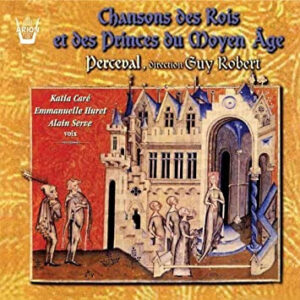Program: #94-05 Air Date: Jan 30, 1994
Preservation of this program is made possible by a generous grant in honor of Marilyn Frances Smith.
I. Tielman Susato—Danserye 1551 (New London Consort/Philip Pickett) L’Oiseau Lyre CD 436.131.
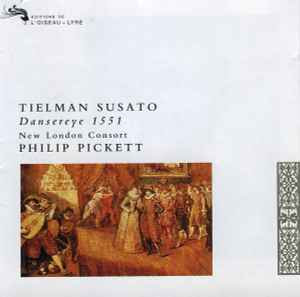
| Fanfare (After 'La Morisque') | 2:02 |
| Passe Et Medio / Reprise 'La Pingue' | 1:26 |
| Bergerette 'Sans Roch' / Reprise | 3:08 |
| Den I. Ronde 'Pour Quoy' | 2:02 |
| Den VII. Ronde 'Il Estoit Une Filette' | 2:29 |
| Den III. Ronde | 1:27 |
| Den IV. Ronde | 0:44 |
| Den V. Ronde ('Wo Bistu') | 0:57 |
| Den VI. Ronde / Saltarelle | 1:51 |
| Den XI. Ronde / Aliud | 1:52 |
| Bergerette 'Dont Vient Cela' / Reprise | 2:18 |
| Danse De Hercules Oft Maticine / De Matrigale | 2:06 |
| De Post | 0:55 |
| Les Quatre Branles | 1:58 |
| Fagot | 0:51 |
| Den Hoboeckendans | 1:48 |
| Basse Danse 'Mon Desir' / Reprise 'Le Cueur Est Bon | 3:45 |
| Den I. Allemainge / Recoupe | 3:30 |
| Den II. Allemainge | 1:02 |
| Den III. Allemainge | 2:01 |
| Den V. Allemainge | 0:46 |
| Den VI. Allemainge | 0:31 |
| Den VII. Allemainge | 0:38 |
| Den VIII. Allemainge / Recoupe/ Recoupe Aliud Den Tenor Voer Den Discant | 1:28 |
| Bergerette ('La Brosse') | 2:10 |
| Pavane 'La Bataille' | 4:31 |
| Pavane 'Mille Regretz' | 1:54 |
| Den II. Gaillard | 1:07 |
| Den XI. Gaillard | 0:44 |
| Den IX. Gaillard | 0:39 |
| Den IV. Gaillard | 1:37 |
| Den VII. Gaillard | 1:28 |
| Den X. Gaillard 'Mille Ducas' | 1:29 |
| Den III. Gaillard | 1:22 |
| Den XV. Gaillard 'Le Tout' | 1:37 |
| Danse Du Roy / Reprise | 2:26 |
| Entre Du Fol | 1:06 |
| Le Morisque | 1:56 |
II. Dufaut/Gallot: Pièces par luth (Pascal Monteilhet). Virgin CD 61776.
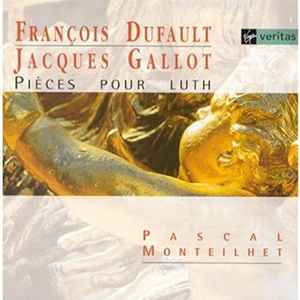
| 1 | Suite For Lute In C Minor | |
| 2 | Suite For Lute In C | |
| 3 | Suite For Lute In G Minor | |
| 4 | Suite For Lute In F Sharp Minor | |
| 5 | Suite For Lute In A Minor | |
| 6 | Suite For Lute In F Sharp Minor | |
| 7 | Suite For Lute In C Major: La Comète, Chanconne | |
| 8 | Suite For Lute In C Minor: L'espagnolette, Passacaille | |
| 9 | Suite For Lute In C Minor: La Mouche, Chaconne |
III. Shakespeare’s Lutenist (Emmay Kirkby/David Thomas/Anthony Rooley). Erato CD 7777593212.
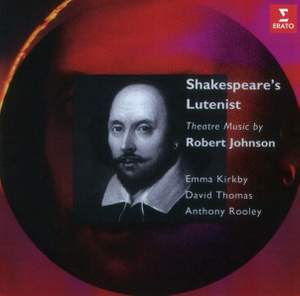
Robert Johnson (c.1582-1633) was associated with The King's Men from c.1610-c.1617, and wrote several songs for the later plays of William Shakespeare. The extent and nature of these performances remains something of a mystery, but Johnson was the most significant composer who has been connected to Shakespeare.
- Where the bee sucks
- Hark, hark! the lark
- Come hither, you that love
- As I walked forth
- Woods, rocks, and mountains
- 'Tis late and cold
- O let us howl
- Arm, arm!
- Come away, Hecate
- Fantasia (lute)
- Pavan (lute)
- Galliard (lute)
- Charon, oh Charon
- Away delights
- Come, heavy sleep
- Care-charming sleep
- Alman I (lute)
- Alman II (lute)
- Alman III (lute)
- Corant (lute)
- Full fathom five
- Have you seen the while lily grow?
- Adieu, fond love
- Come away, thou lady gay
- Tell me, dearest
IV. Popular Music From The Time Of Henry VIII (Hilliard Ensemble/New London Consort). Saga 5444.
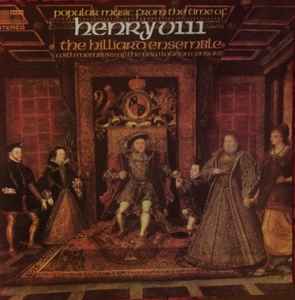
Scotland
1. O Lusty May [1:55]
counter-tenor, tenor, baritone, tenor shawm, tenor & bass sackbuts
Fayrfax Ms.
2. This Day Daws [4:37]
counter-tenor, tenor, baritone
Scotland
3. Begone Sweit Night [3:02]
tenor (PE), lute
Henry VIII's Book
4. HENRY VIII. En Vray Amoure [1:02]
soprano shawm, tenor & bass sackbuts
5. HENRY VIII. O My Heart [1:31]
counter-tenor, tenor, baritone
6. Madame d amours [3:55]
counter-tenor, tenor, baritone, bass
7. Consort Piece XX [1:00]
tenor recorder (PhP), lute
Scotland
8. Absent I Am [3:01]
counter-tenor, tenor, baritone, bass
9. My Heartly Service [5:41]
tenor, baritone, tenor shawm
10. Hey Trolly Lolly Lo! [5:01]
counter-tenor, tenor, baritone
11. Jacques BARBIREAU. En Frolyk Weson [2:07]
counter-tenor, tenor, tenor sackbut
Ritson ms
12. Be Peace! Ye Make Me Spill My Ale! [1:46]
counter-tenor, tenor, baritone
13. The Duke of Somersettes Dompe [1:59]
lute
Henry VIII's Book
14. William CORNYSH. Ah Robin [2:32]
counter-tenor, tenor, baritone
15. I Love Unloved [4:52]
counter-tenor, tenor, baritone
Ritson ms
16. Up I Arose in Verno Tempore [1:34]
baritone, alto & bass cornamuses
Henry VIII's Book
17. Puzzle Canon VI [1:02]
soprano crumhorn, tenor sackbut 18. And I Were a Maiden [2:38]
counter-tenor, tenor, baritone, bass tenor recorder (PN), lute 19. England Be Glad [1:46]
tenor, baritone, bass
V. John Taverner: Missa Mater Christi (The Sixteen/Harry Christophers). Hyperion CD CDA 66639.
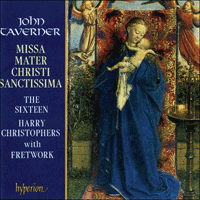
- Hodie nobis caelorum rex [4'59]
- Mater Christi sanctissima [7'21]
- Magnificat a 4 – Nesciens mater Nesciens mater virgo virum [11'46]
- Quemadmodum [4'21]
- Gloria [8'17] Fretwork
Missa Mater Christi sanctissima [34'15]
- Credo [8'03]
- Sanctus [6'17]
- Benedictus [4'55]
- Agnus Dei [6'43]
- In nomine a 4 [2'27] Fretwork
VI. Oswald von Wolkenstein (Sequentia). Deutsche Harmonia Mundi / BMG Classics (05472773022)
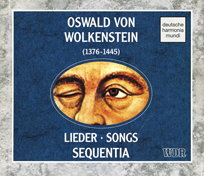
The Tirolian poet, nobleman, adventurer, singer and poet Oswald von Wolkenstein has left an astonishing number of songs to posterity, written under his supervision in luxurious manuscripts of the 15th century. Many of his shorter songs (especially the polyphonic ones) are well-known in performance today, but here Sequentia ventures into the aspect of Oswald’s art which has been most neglected: the long, monophonic storytelling songs. Barbara Thornton and Benjamin Bagby (harp and voice) are joined by fiddlers Elizabeth Gaver and Rainer Ullreich.
- Wolkenstein, Oswald von: Wes mich mein bul
- Wolkenstein, Oswald von: Es seusst dort her von orient
- Wolkenstein, Oswald von: Do Fraig Amors
- Wolkenstein, Oswald von: Es feugt sich
- Wolkenstein, Oswald von: Wer ist, die da durchleuchtet
- Wolkenstein, Oswald von: Work(s)
- Wolkenstein, Oswald von: Wer die ougen wil verschuren
- Wolkenstein, Oswald von: Durch Barbarei, Arabia
- Wolkenstein, Oswald von: Vil lieber Gruss
VII. Wanderers' Voices - Medieval Cantigas & Minnesang (The Newberry Consort). Harmonia Mundi CD – 907082
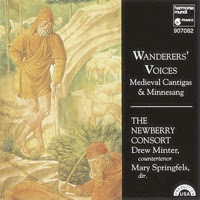
Der UNVERZAGTE
1. Der kuninc Rudolp [2:46]
citole, 2 vielles
NEIDHART
2. Sinc an, guldîn huon! [6:14]
voice, rebec, citole
3. Urloup hab' der winder [2:06]
(Pseudo-NEIDHART) instrumental composition based on it
citole, lute
4. Owe dirre nôt! [4:02]
voice, vielle MS
TANNHÄUSER
5. Ich lobe ein wip [3:35]
rebec, vielle MS, citole
Oswald von WOLKENSTEIN
6. Wol auff, gesell [2:52]
citole, 2 vielles
7. Durch Barbarei, Arabia [4:57]
voice, citole, rebec, vielle MS
8. Freu dich, du weltlich creatur [1:23]
rebec, citole, lute
9. Es seusst dort her von orient [12:27]
voice, vielle DD
ANONYMOUS
10. Jocundare plebs fidelis [5:39]
Codex Las Huelgas | 2 vielles
Cantigas de amigo
Martin CÓDAX
voice, vielle DD, lute, citole
11. Cantiga I. Ondas do mare de Vigo [3:29]
12. Cantiga II. Mandad'ei comigo [3:41]
13. Cantiga III. Mia irmana fremosa [1:42]
14. Cantiga IV. Ai Deus, se sab'ora meu amigo [3:06]
15. Cantiga V. Quantas sabedes amare amigo [1:25]
16. Cantiga VI. Eno sagrado en Vigo [1:51]
17. Cantiga VII. Ai ondas que eu vin veere [2:34]
VIII. Songs and Dances of the Middle Ages (Sonos). Dorian CD 80109.
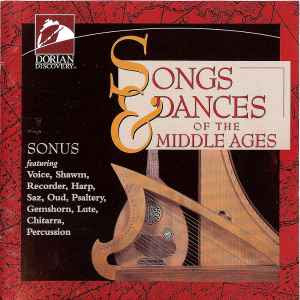
| 1 |
Danca / Lamento Di Tristano / Istanpitta Gaetta, Composed By – Italian 14th Century* |
8:16 |
| 2 | A Virgen Que De Deus Madre, Composed By – Alfonso X El Sabio | 4:31 |
| 3 | Quen A Omagenta, Composed By – Alfonso X El Sabio | 2:49 |
| 4 | Se Ome Fezer, Composed By – Alfonso X El Sabio | 3:02 |
| 5 | A Virgen Mut Groriosa, Composed By – Alfonso X El Sabio | 2:38 |
| 6 | Ay Ondas, Composed By – Martin Codax | 1:57 |
| 7 | Der Kuninc Rudolf | 0:59 |
| 8 | Loibere Risen, Composed By – Wizlav Von Rügen | 3:10 |
| 9 | Sic Mea Fata (Carmina Burana #116), Composed By – Carl Orff | 1:59 |
| 10 | Palastinalied, Composed By – Walther Von Der Vogelweide | 1:15 |
| 11 | Chanconeta Tedesca, Composed By – 14th Century* | 2:02 |
| 12 | Stella Splendens | 2:32 |
| 13 | Mariam Matrem | 1:39 |
| 14 | Imperantz | 3:58 |
| 15 | Los Set Gotex - Cuncti Simus | 3:28 |
| 16 | Polorum Regina | 2:38 |
| 17 | Hocket In Seculum, Composed By – French 13th Century* | 2:12 |
| 18 | Can Vei La Lanzeta Mover, Composed By – Bernard De Ventadour* | 1:37 |
| 19 | Quant Je Voi Yver, Composed By – Colin Muset | 1:56 |
| 20 | Comment Qua Moy, Composed By – Guillaume De Machaut | 3:16 |
| 21 | Dame Ne Regardez Pas, Composed By – Guillaume De Machaut | 3:26 |
| 22 | Reis Glorios, Composed By – Guiraut de Bornhel | 3:11 |
| 23 | Estampie Real, Composed By – French 13th Century* | 3:32 |
IX. Et in terra pax--Geistliche Musik des Mittelalters (Ensemble für Frühe Musik Augsburg). Christophorus CHR 77139.
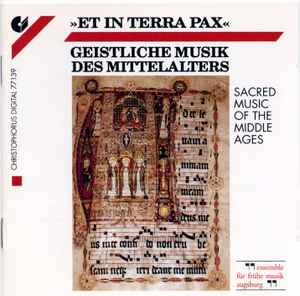
- Motet: Alle psallite cum luya
Bernhard von Clairvaux
- Sequence: Laetabundus exultet fidelis chorus
Anon., 1480, Buxheimer Orgelbuch, München, Bayer. Staatsbibl. Cim., 352b
- Rorate celi desupoer
Anon., Worcester Fragment, 13th c., Worcester, Chapter Library, ms. Add. 68
- Et in terra pax
Adam de la Halle, Paris, Bibl. Nat. fr. 25566
- Dieus soit en cheste maison
Anon., ca 1200, Florence, Bibl. Med.-Lau., Plut. 29.1
- Vetus abit littera
Anon., ca 1200, Florence, Bibl. Med.-Lau., Plut. 29.1; Wolfenbüttel W1, W2, F
- Organum triplum: Benedicamus domino
Anon., 1360, München, Univ. Bibl., Cod. Ms. 2o 156 (Moosburger Graduale)
- Nunc angelorum gloria
Anon., 12th c., Cambridge, Univ. Lib. , Ff I.17
- Latin song: Verbum patris humanatur
Anon., 1480, Buxheimer Orgelbuch, München, Bayer. Staatsbibl. Cim., 352b
- Kyrieleyson de S. Maria v.
Anon., 1360, München, Univ. Bibl., Cod. Ms. 2o 156 (Moosburger Graduale)
- Gaudeat ecclesia
Anon., 15th c. Berlin, Staatsbibl., Prussicher Kulturbesitz, Ms. Germ. 8o 190
- O maiestas deica
Oswald von Wolkenstein Innsbruck, Univ. Bibl., Wolkenstein-Handschrift B
- Song: In Suria ein braiten hall
Anon., ca 1400. Guardiagrele, Chiesa di S. Maria Maggiore, Cod. N. 1
- Alleluya
Anon., ca 1000, Evangeliar of Otto III, Aachen Münsterschatz, from Erfurt, Wiss. Bibl. 4o 332, ca 1400
- Christmas song: Sys willekommen heirre kerst
Oswald von Wolkenstein Innsbruck, Univ. Bibl.. Wolkenstein-Handschrift B
- Lauda: Ave mutter kuniginne
Anon., Bologna, Univ. Bibl.. Ms. 2216
1. Ave mater o Maria
Anon., Venice, Bibl. Naz. Marciana, Ms. 7554
2. Gratia tu nobis data
Oswald von Wolkenstein Innsbruck, Univ. Bibl., Wolkenstein-Handschrift B
3. Dominus te mundi rosam
Anon., Warsawa, Bibl. Narodowa, Ms. III.8054
4. Tecum dominus incarnatus
Anon., Organ tablature from Buxheimer Orgelbuch with text incipit: "Maria tusolacium"
5. Amen ultimo cantamus
X. Mikolaj Gomolka—Polish Psalm Melodies (Warsaw Chamber Choir/Ryszard Zimak). Le Chant Du Monde – LDC 278 1094
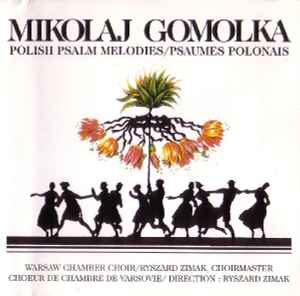
| 1 | Psaume LXXXI | 1:42 |
| 2 | Psaume XI | 2:35 |
| 3 | Psaume CXXXIII | 1:38 |
| 4 | Psaume XLV | 1:10 |
| 5 | Psaume CXXXVII | 1:31 |
| 6 | Psaume CVIII | 1:07 |
| 7 | Psaume XXIX | 1:39 |
| 8 | Psaume I | 1:24 |
| 9 | Psaume XV | 1:56 |
| 10 | Psaume CIII | 1:08 |
| 11 | Psaume LXV | 0:56 |
| 12 | Psaume LXXVII | 1:26 |
| 13 | Psaume CXIX | 1:54 |
| 14 | Psaume XXX | 1:06 |
| 15 | Psaume CXIV | 1:41 |
| 16 | Psaume LVI | 1:09 |
| 17 | Psaume XII | 1:09 |
| 18 | Psaume XCIX | 1:15 |
| 19 | Psaume CXLII | 1:11 |
| 20 | Psaume XXIV | 1:21 |
| 21 | Psaume CL | 1:40 |
| 22 | Psaume XL | 1:29 |
| 23 | Psaume CXXX | 1:28 |
| 24 | Psaume LXX | 1:47 |
| 25 | Psaume XXII | 1:09 |
| 26 | Psaume CI | 1:51 |
| 27 | Psaume XCVIII | 1:32 |
| 28 | Psaume LXI | 1:18 |
| 29 | Psaume CXVII | 1:44 |
| 30 | Psaume LXII | 0:49 |
| 31 | Psaume III | 1:52 |
| 32 | Psaume IX | 1:06 |
| 33 | Psaume XCII | 1:16 |
| 34 | Psaume XXV | 1:08 |
| 35 | Psaume CXXXIV | 1:23 |
| 36 | Psaume XXXI | 1:42 |
| 37 | Psaume XXIII | 1:19 |
| 38 | Psaume CXXXII | 1:44 |
| 39 | Psaume CXLV | 1:12 |
| 40 | Psaume L | 1:29 |
| 41 | Psaume XCL | 1:16 |
| 42 | Psaume XLVII | 1:09 |
XI. Waclaw z Szamotul—Opera Omnia (Chór Chłopięco-Męski Państwowej /Filharmonii W Poznaniu*/Stefan Stuligrosz). Veriton SXV-744.
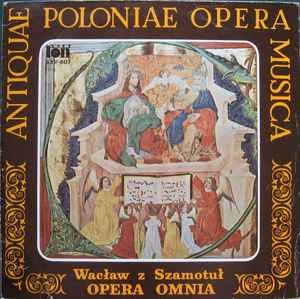
| A1 | In Te Domine Speravi | |
| A2 | Ego Sum Pastor Bonus | |
| A3 | Nunc Scio Vere | |
| A4 | Kryste Dniu Naszej Światlości, Words By – Mikołaj Rej | |
| B1 | Już Się Zmierzcha, Words By – Andrzej Trzecieski | |
| B2 | Pochwalmyż Wszyscy Społem, Words By – Jakub Z Iłży | |
| B3 | Ach Mój Niebieski Panie, Words By – Andrzej Trzecieski | |
| B4 | Blogosławiony Człowiek, Words By – Andrzej Trzecieski | |
| B5 | Nakłoń Panie (Ps. 85), Words By – Mikołaj Rej | |
| B6 | Alleluja. Chwalcie Pana (Ps. 116), Words By – Mikołaj Rej |
XII. The Sweet Look and Loving Manner (Sinfonye/Stevie Wishart). Hyperion CDA 66625.
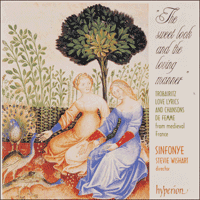
Mores of medieval Provence, the region of France now known as Occitania, gave women a degree of political and creative freedom which appears to have been far greater than in most other times. The twelfth and thirteenth centuries are often seen as something of a renaissance for women and, not surprisingly, it is from this time that we have inherited songs by over twenty female troubadours, known as 'trobairitz' and cited as such in the romance Flamenca (c1250). Their lyrics are particularly poignant as the only female witnesses we have from a courtly milieu whose codes of love still resonate in modern times. The troubadours usually composed their courtly lyrics to fulfil a commission for a particular patron or patroness, but it seems more probable that the much smaller group of trobairitz were wealthy and well-educated women of high social standing whose songs tend to fulfil a more personal expression of the joys and ardour of fin 'amor. Only a small proportion of troubadour lyrics survive with their music, and sadly this is also the case with the trobairitz, for it is only the Comtessa de Dia's most famous love song A chantar m'er (recorded by Sinfonye on Bella Domna, Hyperion CDH55207) that has its melody intact. However, to a certain extent there was some independence between the transmission of the poetry and music. Numerous Occitan songs share the same poetic structure, with an identical number of lines per stanza and number of syllables per line, and even share the same rhyme scheme. It was therefore possible for medieval poet-composers to set their lyrics to a pre-existing melody. This practice of contrafacture was well known throughout the Middle Ages and makes it possible to perform certain of those trobairitz songs which have only their words extant, but replicate the exact poetic structure of another song which has come down to us with its melody intact.
There are four dialogue songs conducted solely between trobairitz, and our opening pair of tensos share identical metrical structures with troubadour songs. Na Carenza steps outside the usual rhetoric of the courtly love song with two sisters asking questions of marriage and childbirth. There are a number of possible contrafact melodies and Aimeric de Peguillan's Atress-im pren com fai al jugador is particularly arresting with its unusual use of Phrygian mode. It is interesting to find that the contrafact melody for our second trobairitz dialogue also shares similar distinctive melodic features with its initial use of phrygian intervals. This two-stanza cobla takes up the conventional themes o f fin 'amor with one trobairitz, Iseut de Capio, asking her colleague, Almuc de Castelnau, to forgive a deceitful lover and end his suffering. The source of this contrafact is Uc de Saint Circ's Anc enemics q 'eu agues.
The majority of tensos are in the form of courtly debates between two troubadours, or occasionally the stanzas alternate between male and female protagonists. In Bona domna the troubadour Pistoleta debates with an anonymous trobairitz, and this tenso has a particularly convincing contrafact melody as it accompanies another song which is again by Pistoleta. There are two versions of this exquisite melody. We perform the one from the St Germain Chansonnier as a fiddle prelude to introduce the complete song which uses the version from the Cangé Chansonnier.
We also include two works by trobairitz poets who adopt the more serious high style love song which is known in Occitan as the canso. One of the most controversial is attributed to the trobairitz Beatritz de Romans who addresses her sentiments of fin 'amor to another woman, Na Maria. Although there is no exact contrafact, the unique nature of the text warranted its inclusion. Gaucelm Faidit's canso Mon cor e mi e mas bonas chansos mirrors the poetic structure of Na Maria almost exactly, needing only slight modification of its melody to accommodate an extra syllable in the final pair of lines of Beatritz's stanzas. Our second canso fares rather better, having two possible contrafact melodies attached to poems which both replicate its structure throughout. Estat ai is one of the five extant cansos by the Comtessa de Dia and is sung to the melody of Bernart de Ventadorn's canso Non es meravilla s'eu chan which survives in different versions in the Milan Chansonnier and Chansonnier du Roi. We perform the former rather engimatic melody as a prelude to the Comtessa's canso. Her song expresses the conventional courtly epithets of unrequited love but with a directness and passion that seem particularly characteristic of the Comtessa's poetic style.
The Occitan love songs tend to adopt through-composed melodies which are often musically adventurous and highly sophisticated, reflecting the ingenuity of their texts. The songs of the northern courts rework some of the sentiments of their southern predecessors, but are often more immediately accessible with a narrative theme, less rhetorical or poetically complex texts which are often refrain-based, and easily memorable melodies. The chanson de femme and chanson de toile both adopt the convention of having female protagonists, but are usually anonymous and may be of male or female inspiration. Complaints of an unhappy wife ('mal mariée') abound, often as comical send-ups, as in the dance-song Soufrés, maris, but often with more serious undertones as in Por coi me bait mes maris?
- Careza, Alais, Iselda:
- Na Carenza
- Iseut de Capio & Almuc de Castelnau:
- Domna N'Almucs, si-us plages
- Beatriz de Romans:
- Na Maria
- Anon:
- Soufrés, maris
- Toute seule, passerai
- Por coi me bait mes maris?
- Anon & Pistoleta:
- Bona domna, un conseill vos deman
- Anon:
- C'est la gieus en mi les prez
- C'est desoz l'olive en mi les prez
- La jus desouz l'olive
- Et une chambre cointe et grant / Et Gaudebit (instrumental)
- Main s'est levee Aëlis / Ne (instrumental)
- Tout leis en mi les prez / Dominus (instrumental)
- Ventadorn:
- Non es meraveilla s'eu chan (instrumental)
- Comtessa de Dia:
- Estat ai en greu cossirier
- Wishart & Comtessa de Dia:
- Estampie on "A chantar m'er" (instrumental)
- Anon:
- Bele Doette as fenestres se siet
- Marie de Dregnau de Lille:
- Mout m'abelist quant le voi (instrumental)
- Audefroi le Bastart (fl.1215):
- Bele Emmelos (instrumental)
- Anon:
- Avant hier en un vest pre (instrumental)
- Li debonnaires Dieus (instrumental)
XIII. Chansons des Rois et des Princes du Moyen Age: Perceval. (Ensemble Guy Robert). Arion CD ARN 68031.
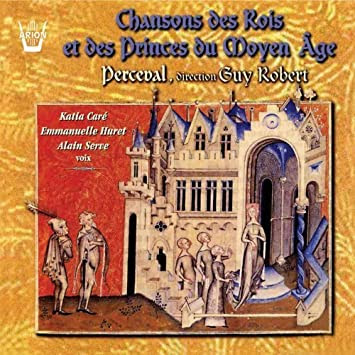
| THIBAUD IV, Comte De Champagne Et Roi De Navarre | ||
| 1 | J'Aloie L'Autrier Errant (Pastourelle) | 3:55 |
| 2 | Du Très Douz Non À La Virge Marie (Chansons Mariale) | 9:49 |
| 3 | Dame, Merci (Jeu Parti Entre Thibaud Et Une Dame) | 4:52 |
| 4 | Seigneur, Sachez Qui Ore Ne S'En Ira (Chanson De Croisade) | 3:41 |
| ALFONSO X EL SABIO, Roi De Castille Et Du Léon | ||
| 5 | Null' Ome Per Ren Non Deve (Cant. N°361) | 6:44 |
| 6 | Virgen Santa Maria (Cant. N°47) | 5:19 |
| 7 | Como Poden Per Sas Culpas (Cant. N°166) | 3:39 |
| CHARLES D'ANJOU, Roi De Naples | ||
| 8 | La Plus Noble Emprise Qui Soit (Lai) | 6:56 |
| GUILLAUME VII DE POITIERS, Duc D'Aquitaine | ||
| 9 | Pos De Chantar (Planh) | 5:27 |
| CONON DE BÉTHUNE, Régent De L'Empire De Constantinople | ||
| 10 | L'Autrier Avint En Cel Autre Païs (Débat Entre Un Chevalier Et Une Dame) | 3:39 |
| RICHARD-CŒUR-DE-LION, Roi d'Angleterre | ||
| 11 | Ja Nul Hons Pris Ne Dira Sa Raison (Rotrouenge) | 7:32 |
Composer Info
FRANÇOIS DUFAULT, JACQUES GALLOT, Robert Johnson (c.1582-1633), William CORNYSH, Jacques BARBIREAU, HENRY VIII, John Taverner (c1490-1545), Oswald von Wolkenstein, NEIDHART, Der UNVERZAGTE, TANNHÄUSER, Istanpitta Gaetta, Alfonso X El Sabio (1221–1284), Martin Codax, Wizlav Von Rügen (c.1268-1325), Carl Orff (1895 –1982), Walther von der Vogelweide (1170-1230 CE), Bernart de Ventadorn (1130-1140 – 1190-1200), Colin Muset (~1200), Guillaume de Machaut (1300-1377), Guiraut de Bornhel, Montpellier, Bernhard von Clairvaux, Adam de la Halle, Oswald von Wolkenstein Innsbruck, Mikolaj Gomolka, Waclaw z Szamotul, Careza, Alais, Iselda, Iseut de Capio , Almuc de Castelnau, Beatriz de Romans, Pistoleta, Ventadorn, Comtessa de Dia, Wishart, Marie de Dregnau de Lille, Audefroi le Bastart (fl.1215)
CD Info
L’Oiseau Lyre CD 436.131, Virgin CD 61776, Erato CD 7777593212, Saga 5444, Hyperion CD CDA 66639, Deutsche Harmonia Mundi / BMG Classics (05472773022), Harmonia Mundi CD – 907082, Dorian CD 80109, Christophorus CHR 77139, Le Chant Du Monde – LDC 278 1094, Veriton SXV-744, Hyperion CDA 66625, Arion CD ARN 68031
